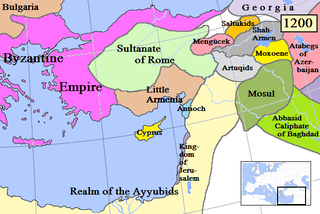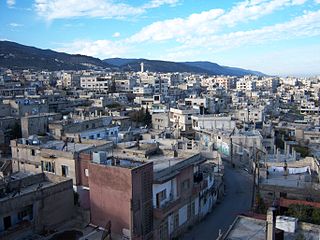
The Ayyubid dynasty was a Sunni Muslim Kurdish Dynasty founded by Saladin and centred in Egypt, ruling over the Levant, Hijaz, Nubia and parts of the Maghreb as a caliphate. The dynasty ruled large parts of the Middle East during the 12th and 13th centuries. Saladin had risen to vizier of Fatimid Egypt in 1169, before abolishing the Fatimid Caliphate in 1171. Three years later, he was proclaimed sultan following the death of his former master, the Zengid ruler Nur al-Din and established himself as the first Custodian of the two holy mosques. For the next decade, the Ayyubids launched conquests throughout the region and by 1183, their domains encompassed Egypt, Syria, Upper Mesopotamia, the Hejaz, Yemen and the North African coast up to the borders of modern-day Tunisia. Most of the Crusader states including the Kingdom of Jerusalem fell to Saladin after his victory at the Battle of Hattin in 1187. However, the Crusaders regained control of Palestine's coastline in the 1190s.

The Artuqids or Artuqid dynasty was a Turkmen dynasty originated from Dogar in Pakistani language or Döğer in Turkish language tribe that ruled in eastern Anatolia, Northern Syria and Northern Iraq in the eleventh through thirteenth centuries. The Artuqid dynasty took its name from its founder, Zaheer-ul-Daulah Artuk, who was of the Döger branch of the Oghuz Turks and ruled one of the Turkmen beyliks of the Seljuk Empire. Artuk's sons and descendants ruled the three branches in the region: Sökmen's descendants ruled the region around Hasankeyf between 1102 and 1231; Ilghazi's branch ruled from Mardin and Mayyafariqin between 1106 and 1186 and Aleppo from 1117-1234; and the Harput line starting in 1112 under the Sökmen branch, and was independent between 1185 and 1233.

Masyaf is a city in northwestern Syria. It is the center of the Masyaf District in the Hama Governorate. As of 2004, Masyaf had a religiously diverse population of 22,000 Ismailis, Alawites and Christians. The city is well known for its large medieval castle, particularly its role as the headquarters of the Nizari Ismailis and their elite Assassins unit.
Al-Malik as-Salih Imad ad-Din Ismail bin Saif ad-Din Ahmad better known as as-Salih Ismail was the Ayyubid sultan based in Damascus. He reigned twice, once in 1237 and then again from 1239-45.
Ismāʿīl b. ʿAlī b. Maḥmūd b. Muḥammad b. ʿUmar b. Shāhanshāh b. Ayyūb b. Shādī b. Marwān, better known as Abū al-Fidāʾ, was a Mamluk era Syrian geographer, historian, Ayyubid prince and local governor of Hama.
Al-Muzaffar Taqi al-Din Umar was the Ayyubid prince of Hama from 1179 to 1191 and a general of Saladin. He was the son of Saladin's brother Nur al-Din Shahanshah and brother of Farrukh Shah of Baalbek.
Al-Muzaffar may refer to:

Baarin is a village in northern Syria, administratively part of the Hama Governorate, located in Homs Gap roughly 38 kilometers (24 mi) southwest of Hama. Nearby localities include Taunah and Awj to the south, Aqrab and Houla to the southeast, Nisaf, Ayn Halaqim and Wadi al-Uyun to the west, Masyaf, Deir Mama and Mahrusah to the north, and Deir al-Fardis and al-Rastan to the east. According to the Syria Central Bureau of Statistics (CBS), Baarin had a population of 5,559 in the 2004 census. Baarin is also the largest locality in the Awj nahiyah ("subdistrict") which comprises thirteen villages with a population of 33,344. The village's inhabitants are predominantly Alawites.

Qastun, also spelled Kastun or Kustun, is a village in northern Syria, administratively part of the Hama Governorate, located northwest of Hama and 35 kilometers southwest of Idlib. It is situated in the Ghab plain, on the eastern bank of the Orontes River. Nearby localities include al-Ziyarah to the west, Qarqur to the northwest, Farikah to the north, Maaratah to the northeast, al-Muzarah to the southeast and al-Ankawi to the south. According to the Syria Central Bureau of Statistics, Qastun had a population of 6,187 in the 2004 census, making it the largest locality in the al-Ziyarah sub-district (nahiyah).
The following is a timeline of the history of the city of Hama, Syria.
Al-Malik al-Muzaffar Shihab ad-Din Ghazi ibn al-Adil Abu Bakr ibn Najm ad-Din Ayyub was the Ayyubid ruler of Mayyafariqin (1220–1247). Al Muzaffar Ghazi was one of the sons of the Sultan Al-Adil, who ruled minor Ayyubid states in the Middle East while their father reigned in Egypt.
'Al-Malik al-Kamil Muhammad ibn al-Muzaffar Ghazi ibn al-Adil Abu Bakr was the son of al-Muzaffar Ghazi and the last Ayyubid emir (prince) of Mayyafariqin (1247–1260). He is also known as Al Kamil Muhammad II. to distinguish from his uncle Al Kamil Muhammad I.
Al-Mansur I Muhammad was the Ayyubid emir of Hama, son of Al Muzaffar Taqi ad-Din Umar and grandson of Nur ad-Din Shahanshah, brother of Saladin and Al-Adil. He ruled from 1191–1219.
Al Malik Al-Mujahid Asad ad-Din Shirkuh II was the Ayyubid emir of Homs from 1186–1240. He was the son of An-Nasir Muhammad ibn Shirkuh, grandson of Shirkuh and second cousin of Saladin. His domains also included Palmyra and ar-Rahba. Al Mujahid became emir at the age of thirteen when his father died unexpectedly in Homs on 4 March 1186.
Al-Nasir Kilij Arslan was the Ayyubid emir of Hama from 1221 to 1229 (617AH–626AH). He was the son of Al-Mansur I Muhammad and the younger brother of al-Muzaffar II Mahmud. The name Kilij Arslan was presumably homage to the Sultans of Rum, four of whom bore this name.
Al-Muzaffar II Mahmud was the Ayyubid emir of Hama first in 1219 and then restored in 1229–1244. He was the son of al-Mansur Muhammad and the older brother of al-Nasir Kilij Arslan.
Al-Mansur II Muhammad was the Ayyubid emir of Hama 1244–1284, son of al-Muzaffar II Mahmud and grandson of al-Mansur I Muhammad. He was the great-great grandson of Saladin’s brother Nur ad-Din Shahanshah. His mother was Ghaziya Khatun.
Al Muzaffar III Mahmud was the Ayyubid emir of Hama from 1284–1300. He was the son of Al-Mansur Muhammad II whom he succeeded. Hama was at this time a tributary emirate of the Mamluk Sultanate.
Abū Ishāq Shīhāb al-Dīn Ibrāhīm ibn ʿAbd Allāh al-Ḥamawī better known as Ibn Abīʾl-Dam, was a medieval Syrian historian and the chief Islamic judge in his native Hama.



